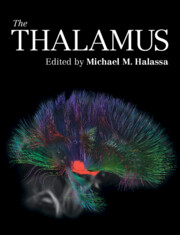Book contents
- The Thalamus
- The Thalamus
- Copyright page
- Contents
- Contributors
- Preface
- Section 1: History
- Section 2: Anatomy
- Chapter 2 Organization of Thalamic Inputs
- Chapter 3 Thalamic Output Pathways
- Chapter 4 Thalamocortical Circuitry Matters
- Section 3: Evolution
- Section 4: Development
- Section 5: Sensory Processing
- Section 6: Motor Control
- Section 7: Cognition
- Section 8: Arousal
- Section 9: Computation
- Index
- References
Chapter 4 - Thalamocortical Circuitry Matters
from Section 2: - Anatomy
Published online by Cambridge University Press: 12 August 2022
- The Thalamus
- The Thalamus
- Copyright page
- Contents
- Contributors
- Preface
- Section 1: History
- Section 2: Anatomy
- Chapter 2 Organization of Thalamic Inputs
- Chapter 3 Thalamic Output Pathways
- Chapter 4 Thalamocortical Circuitry Matters
- Section 3: Evolution
- Section 4: Development
- Section 5: Sensory Processing
- Section 6: Motor Control
- Section 7: Cognition
- Section 8: Arousal
- Section 9: Computation
- Index
- References
Summary
Once thought to be a simple relay, the thalamus is now seen as a more dynamic player in overall cortical functioning. Several relatively recent observations created led to this new understanding: (1) Glutamatergic inputs can be classified as drivers (e.g., main conveyors of information) or modulators. Most inputs in the thalamus and cortex are modulators, and identifying the driver subset has provided insights into thalamocortical circuit functioning. (2) Much of the modulator input to the thalamus relates to control of the response mode of relay cells–tonic or burst. Which mode operates at any time affects the significance of the message conveyed to the cortex. (3) We now appreciate that most of thalamus, called higher order (e.g., pulvinar and medial dorsal nucleus), serves as a central relay in a transthalamic corticocortical information route organized in parallel with direct connections. First-order nuclei (e.g., lateral geniculate and ventral posterior nuclei) instead relay peripheral information to the cortex. Thus, the thalamus not only provides a behaviorally relevant, dynamic control over the nature of the information relayed, but it also plays a key role in basic corticocortical communication. These findings are reviewed, along with speculations regarding the functional significance of transthalamic pathways.
- Type
- Chapter
- Information
- The Thalamus , pp. 71 - 90Publisher: Cambridge University PressPrint publication year: 2022



